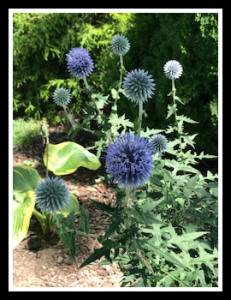Plants of various types rub shoulders in my garden — perennials, annuals, small trees, veggies, and vines. Most of these I planted. A few self-planting plants, however, I did not. Or in two instances, I planted the plant where I wanted it, and it moved to where it wanted to be. Here are brief descriptions of my uninvited or pushy, self-planting garden residents.
Willow Tree
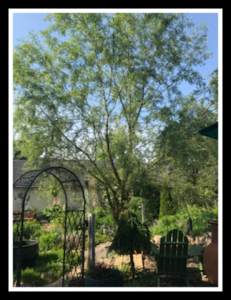
This self-planting willow shades our pond and makes sitting beside it more comfortable.
The biggest example among my self-planting plants is the willow (salix) tree beside our pond. The seed of this tree floated in on the air and planted itself where it still stands. For several years, we cut it way back to keep it small. It, however, as willows do, wanted to grow big. Today, it is about 15 feet tall, and it shades the pond beautifully, making the chairs beside it much more comfortable to sit in throughout the day. We prune it rather severely each year to keep it at this size.
I have another willow tree in my garden — a corkscrew willow. This tree is not the mother of the one that invited itself, because their branching structures are entirely different. Other than knowing it’s not a corkscrew willow, I don’t know the species of our pond willow. The Spruce offers an overview of several common species of willow trees.
I like many things about this willow. Its branches are light and blow in the wind beautifully, making a lovely play of light and shadow that I enjoy. It’s one of the first trees to leaf out in the spring, when the site of anything green is so welcome. The birds seem to like the tree, often landing in it for a burst of song. But perhaps my favorite reason for becoming so fond of this self-planting tree is that one of my granddaughters really likes it, too. “It’s a ‘my-size’ tree,” she told me one day.
Cushion Spurge
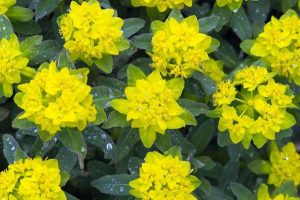
Cushion spurge (image taken from the internet) glows bright acid yellow in the early spring.
Cushion spurge (euphorbia polychroma) is a fun plant to have in the garden. A compact, clump-forming herbaceous perennial, it blooms early in the spring a bright acid yellow color. When little else is blooming, it’s a welcome sight. The blooms are not actually flowers, but rather bracts or modified leaves, which means they spice up the garden for a long time.
Cushion spurge propagates by self-seeding where it’s happy — and it must be happy in my yard. My front garden is divided into two parts separated by a walk. I planted the cushion spurge on one side of the walk. The wind must have carried the seeds to the other side, for that’s where it is today. I don’t mind. It’s a lovely self-planting spring sight, wherever it lives.
Cushion spurge is not native to North America, so I probably would not plant a new one, since my goal is to gradually convert to mostly native plants. But I’ll certainly keep and enjoy the ones that I have.
Globe Thistle
Globe thistle (echinops ritro) is another self-planting garden resident that moved. We planted it in a grass garden, thinking the coarse leaves and round blooms would make a nice contrast to the slim fronds of the grasses. The globe thistle did reasonably well there, but it decided that it would prefer to be across the sidewalk in a bed that has somewhat looser and richer soil. So it moved.
I love this thistle because it is so weird and different from any other plant in my garden, self-planting or no. It grows to about three feet in height, and it propagates easily. I started with one. Now there are three, and I didn’t plant the last two. Every spring, I spend an hour or two pulling up many baby plants we don’t have room for.
The plant blooms in July and August, and the bees absolutely adore the round, spiky blue balls it produces. I can count on seeing up to six or seven bees whenever I pass this self-planting treasure — and that alone is reason enough to keep this plant in my garden. While the flowers themselves don’t last too long, their blue color remains for quite a while.
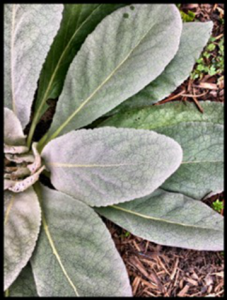
Aren’t mulleins interesting to look at? They are interesting to touch as well.
Mullein
Mullein (verbascum thapsus) is the common name of verbascum, sometimes called velvet plant. The reason why the plant got this nickname is obvious. The leaves are huge at the bottom and very soft and velvety to the touch. My first mullein must have come in on the wind. Suddenly, I had this interesting plant with a mound of gray-green basal leaves and a tall stalk with yellow flowers. Mulleins can grow quite large if the conditions are right. My tallest one was over six feet, and the basal leaves were close to three feet in diameter.
Right at this moment, I have half a dozen self-planting mulleins. Mulleins are biennial. The basal leaves develop in year one. The stalk climbs to the sky in year two. And then it’s gone, and another — or several — will appear the following year. Interestingly enough, you never know where your new mulleins will show up.
Mulleins will certainly add interest to any garden. They remind me of exclamation points!
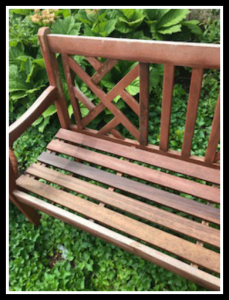
This bench sits in a pool of self-panting violets, lovely with purple flowers in spring, and a good ground cover as well.
Violets
I have a bench in my garden that sits in a puddle of violets (viola). I didn’t plant a single one of these self-planting ground-cover plants. Low growers, they , have heart-shaped, scalloped leaves, and in early spring, lovely purple flowers. They make a nice base for my bench, and they add a touch of nostalgia. I remember seeing violets growing in the lawn when I was growing up — so having them in my garden is a real pleasure. And of course, there’s the old childhood poem that they bring to my mind: “Roses are red, violets are blue, sugar is sweet, and so are you!”
You may have self-planting plants in your garden, too. I hope you get the same pleasure from these uninvited garden residents as I do.
Like this post? Sign up to receive an email each time a new post is available. We will never loan, sell or rent your email address — that’s a promise! Please use the buttons below to share with others — and please comment. It’s nice to hear your thoughts.
